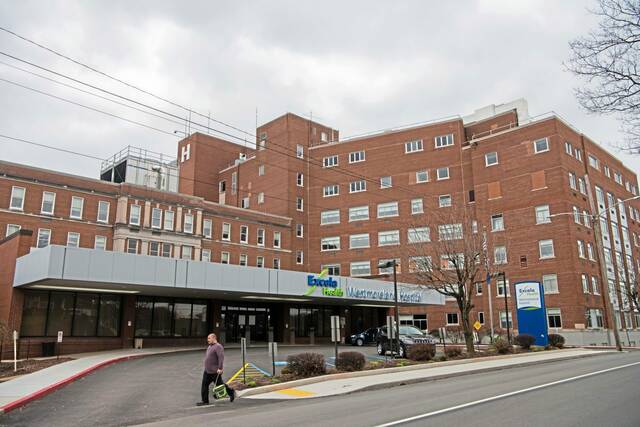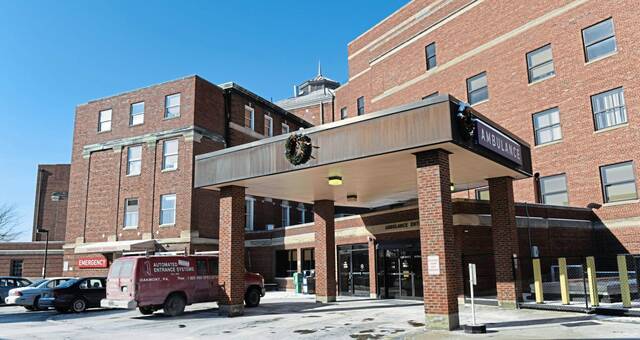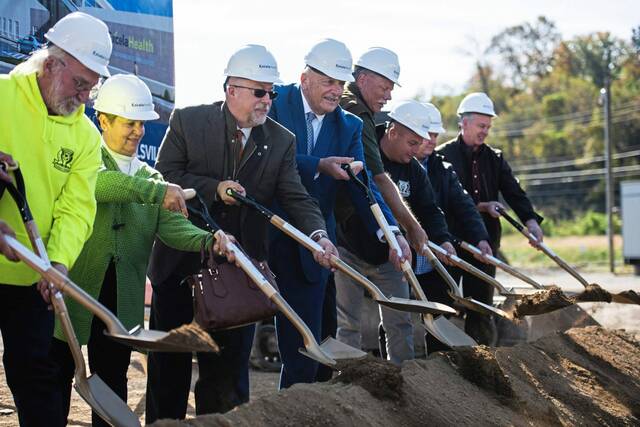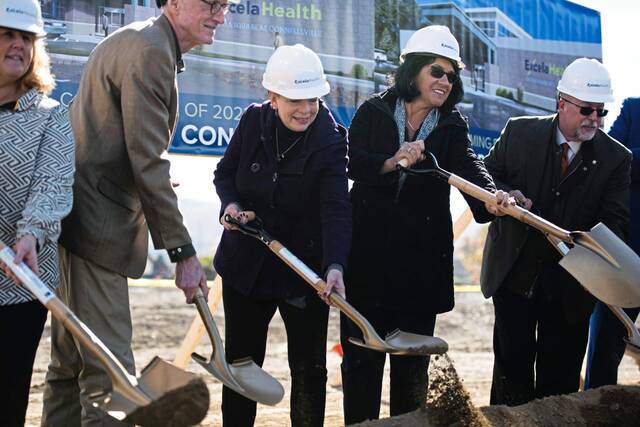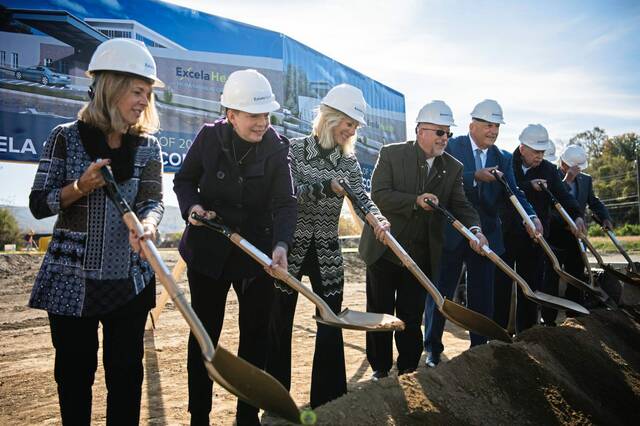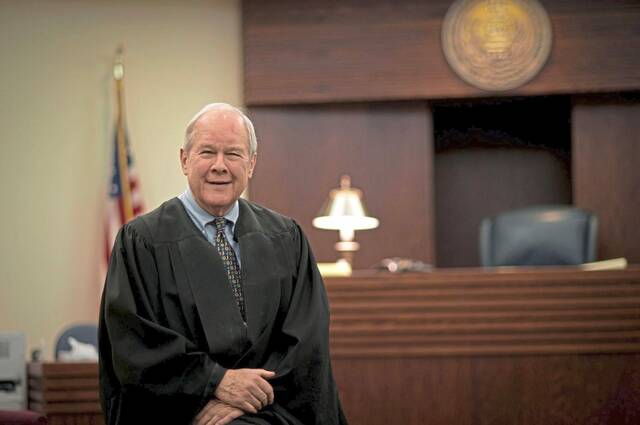Hospitals embrace mergers as path to survival
Editor’s note: This is the second part of a three-day series examining the rapidly changing health care landscape in Western Pennsylvania.
As Excela Health CEO John Sphon irons out the details of a merger with Butler Health System, his message to the public is clear.
He believes the alliance will ensure the system is a viable, long-term player in a highly competitive health care market, but he said it’s not an attempt to battle Western Pennsylvania giants UPMC or Allegheny Health Network.
“We have no desire nor intent to enter into a health care arms race with UPMC or AHN,” Sphon said. “We will not compete on a field measured by expansion.
“We will, however, compete on the field of quality of care. That focused use of capital, one that is motivated by what is in the best interest of our patients and their families, is what drives us. We have no desire to be the biggest, just the best in what we do.”
But Sphon and other executives at smaller health care systems have realized the path to being “the best” might require merging with similar systems to overcome challenges such as rising labor costs, decreasing inpatient admissions and ongoing fallout from the covid-19 pandemic.
In this region, those problems have been amplified as UPMC and Allegheny Health Network continue to spend billions of dollars to broaden their presence and West Virginia University Health System stretches across the Pennsylvania border to grow its footprint in Fayette County.
With every health system attempting to grab its share of patients, four recent significant mergers have occurred in the region:
• Excela Health and Butler Health inked an intent-to-merge agreement this past summer. The merger would join five hospitals in Westmoreland, Butler and Clarion counties.
• Penn Highlands Healthcare finalized a merger with Highlands Hospital in Connellsville this year.
• Penn Highlands also merged with Monongahela Valley Hospital in Carroll Township, Washington County, last year.
• West Virginia University Health System and Uniontown Hospital merged in 2020, spurring $15 million in renovations and improvements at the Fayette County facility to date. Since then, WVU’s presence in the county has continued to grow with more practices and widespread television advertising urging patients to utilize its new pediatric hospital in Morgantown, about 25 miles from Uniontown.
“The idea of mergers of community-based hospitals is partly driven by the need to be able to leverage all of those assets together and be able to borrow money, to buy supplies and make capital investments at lower rates and to have the benefits of a larger system,” said retired Westmoreland County Judge John Driscoll.
Driscoll was a board member as Excela Health was formed in 2003-04, the result of Westmoreland Health System — which operated Westmoreland Regional Hospital in Greensburg and Frick Hospital in Mt. Pleasant — merging with Latrobe Area Hospital.
“There are a lot of challenges … but that’s the idea behind it: that you have the ability to maintain these community-based systems and compete where appropriate,” Driscoll said.
Related:
• As Western Pa. hospitals expand, fears grow over higher health care costs
As the merger was being completed in 2004, all three hospitals were losing money — Westmoreland and Frick had combined losses of $9 million, while Latrobe had $4 million in losses, according to disclosure forms.
In the next fiscal year, the merged system posted a $4.4 million profit, those forms show.
“I think Excela is in a better position now than it would have been if we would have continued to compete as individual hospitals,” said Douglas Clark, former CEO of Latrobe Hospital, who also served as Excela’s president.
Ge Bai, an accounting professor at Johns Hopkins University who specializes in health care pricing, policy and management, agrees there usually is a “tipping point” when the decision is made to merge.
In Pennsylvania, only 15% of hospitals remain independent, said Liam Migdail, spokesman for the Hospital and Healthsystem Association of Pennsylvania. The remaining 85% are affiliated with 39 health systems, he said.
Those numbers reflect national trends.
In the decade ending in 2021, almost 1,020 partnerships, mergers and acquisitions were reported among U.S. hospitals and health systems, according to Kaufman, Hall & Associates, a Chicago management consulting firm working with health care organizations.
In addition to other market challenges, the pandemic ravaged budgets, ignited supply-chain problems and caused ongoing labor shortages — factors that are accelerating mergers and acquisitions nationwide, the report indicated.
“Covid was a storm hitting everyone,” Bai said. “The small ones are more likely to fall and more likely to be vulnerable, so they have a strong incentive to join a bigger network. And the larger ones take the opportunity … to expand their power.”
And that is likely not the endpoint, said Dr. Kevin Broom, associate professor of health policy and management at the University of Pittsburgh School of Public Health.
“There will be something that will happen down the road. It’s just a matter of how far down the road,” Broom said. “Will they be merging with something else in the middle of the state and form kind of a larger system that’s more suburb and rural centric? Will they become part of a UPMC or an Allegheny Health down the line? Or maybe a West Virginia Medicine moving up? It’s kind of the nature in the health industry.”
Impact of Excela-Butler merger
The Excela-Butler merger is expected to generate more than $1 billion in revenue and could employ 7,300 people, with more than 1,000 physicians and practitioners serving about 750,000 people in Butler, Clarion and Westmoreland counties, Sphon said.
The yet-to-be-named system would join Excela’s Frick Hospital, Latrobe Hospital and Westmoreland Hospital with the two Butler Health System hospitals — Butler Memorial Hospital in Butler and Clarion Hospital in Monroe Township, Clarion County.
The proposed merger comes as both systems struggle financially.
A recent disclosure report from Excela reflects that for the nine months ending March 31, the health system saw a $10.5 million operating loss.
Butler Health System was in a similar situation with $8.2 million in operating losses in the 12 months ending March 31, according to a third-quarter financial report.
Penn Highlands expands
So much was going against Connellsville’s Highlands Hospital when the Penn Highlands Health System entered the picture.
One of the poorest counties in the state, Fayette saw its population drop nearly 8% — to about 127,000 — between 2010 and 2021, according to Census figures. With nearly 20% of its residents living at or below the poverty level, its average individual income stands at $27,778, well below the statewide average of $35,518.
From 2011 to 2020, Highlands Hospital was in the red, with its largest deficit of almost $6.3 million coming in 2020 in the midst of the pandemic.
Penn Highlands officials refused to be interviewed for this story, stating they do not discuss their strategy in the media. But some portrait of the Clearfield County-based operation that began in 2011 is available to the public.
The system has grown to include eight hospitals; cancer, lung and heart treatment centers with locations across the state; long-term care facilities; and walk-in clinics, according to the Penn Highlands website. A ninth hospital is in the works in State College: a $70 million facility that is expected to open in 2024.
Last year, it added Monongahela Valley Hospital to its properties.
Like Highlands Hospital in nearby Connellsville, it had seen its share of struggles.
A 2020 annual report for the hospital shows a $12.4 million operating loss attributed to fallout from the pandemic. A year earlier, the hospital posted a $2 million loss. But according to tax documents, financial problems plagued the facility for nearly a decade before the pandemic began.
The financial picture is considerably rosier within the consolidated profile of the Penn Highlands facilities, according to public records.
In the quarter ending March 31, Penn Highlands reported $20 million in operation profits, according to financial reports. In the same period last year, the health system reported $33.8 million in operating profits, those reports indicate.
Before the merger, there was fear in Connellsville about losing the hospital. But those fears were allayed when Penn Highlands merged with Highlands.
“We definitely need the hospital. And if the merger helps the hospital to stay here, then it’s a wonderful thing,” said Barry Craig, owner of Craig’s Appliances and president of the Connellsville Area Community Ministries.
Craig said he hasn’t seen sweeping physical changes at the facility, but the fact the doors have remained open is a blessing.
Now Connellsville, just 10 minutes from the Westmoreland County border and 30 minutes from the West Virginia line, has become a battleground for patients by Penn Highlands and WVU Medicine, which operates a primary care office in town. Excela Health also recently broke ground on a $12 million outpatient and ambulatory care center expected to open next year.
WVU makes its presence known
Just about 11 miles down Route 119 from Connellsville, the blue-and-yellow WVU Medicine banner hanging from the front of Uniontown Hospital makes it clear the West Virginia health system is in Pennsylvania to stay.
“It was born out of, I think, this hospital and their board recognizing that the days of a sole community hospital in Pennsylvania and West Virginia are probably about over,” said Dr. David Hess, CEO of Uniontown Hospital and WVU Medicine United Hospital Center in Bridgeport, W.Va.
The partnership, announced in 2020, took root after Uniontown Hospital was ravaged by the pandemic, after posting losses for most of the past decade, according to records maintained by the Pennsylvania Health Care Cost Containment Council.
A lethal blow came in 2019 when UPMC pulled out of a physician partnership, leaving Uniontown to find another partner for “physician recruitment and economic viability,” said Steven Handy, former Uniontown Hospital CEO. “And what we were able to do then was actually to merge with WVU.”
That merger, Handy said, was key to Uniontown Hospital’s survival.
“If you just look at all the new physicians … it’s very impressive,” Handy said. “The additional access to physician specialties in Uniontown wasn’t able to be done there before.”
This year, the hospital reopened its maternity unit, which had closed in 2019.
Today, the hospital offers several specialties, including a heart and vascular institute, a cancer center and an orthopedic and spine center. Over the past 18 months, 30 doctors were recruited, salaries were increased and benefits were approved.
In addition to Uniontown and Connellsville, WVU Medicine has expanded into Carmichaels and Waynesburg in Greene County. Hess said the health system plans to move into northern Fayette County and southern Westmoreland County.
He said there are no concerns about possible competition from UPMC, AHN and Excela, noting that WVU Medicine is a “great health system at taking care of rural communities or smaller communities like Fayette County and Greene County.”
“We try to make health care difficult sometimes, but health care is pretty simple,” Hess said. “When you have the best doctors, you win, and we think we’re really good at recruiting incredible doctors, and we think great doctors in any market do very well.”
Chrissy Smith, manager at Goodie Girls Cake Shoppe in downtown Uniontown, said she is happy WVU came to town.
She said the change in the quality of care at the hospital is apparent.
“It used to feel unreliable,” Smith said. “Now it feels like forward progress.”
Merger concerns
Mergers often are touted as beneficial to patient care, but some experts have expressed concerns about decreases in competition.
Those concerns were expressed in a 2021 statement from Martin Gaynor, professor of economics and public policy at Carnegie Mellon University, to the U.S. Senate Committee on the Judiciary’s Subcommittee on Competition Policy, Antitrust and Consumer Rights.
Gaynor argued that mergers have led to local areas being dominated by “one large, powerful health system,” with examples given for UPMC in Pittsburgh, Partners HealthCare in Boston and Sutter Health in San Francisco.
“Extensive research evidence shows that consolidation between close competitors leads to substantial price increases for hospitals, insurers and physicians, without offsetting gains in improved quality or enhanced efficiency. … Just as seriously, if not more, evidence shows that patient quality of care suffers from lack of competition,” Gaynor said.
Bai agreed.
“The government, I think they’re very well-intentioned — both the state and the federal governments — but … they almost always favor the large systems,” Bai said.
Remove the ads from your TribLIVE reading experience but still support the journalists who create the content with TribLIVE Ad-Free.


